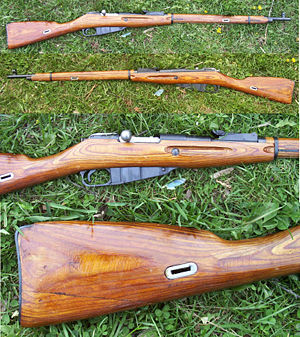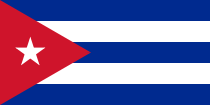Mosin-Nagant
| Mosin-Nagant M91/30 | |
|---|---|
 |
|
| Type | Bolt-action rifle |
| Place of origin | |
| Service history | |
| In service | 1891-1998 |
| Used by | See Users |
| Wars | Russo-Japanese War, Russian Civil War, World War I, World War II, Korean War, Vietnam War, numerous others |
| Production history | |
| Designer | Captain Sergei Mosin, Léon Nagant |
| Designed | 1891 |
| Manufacturer | Tula, Izhevsk, Sestroryetsk, Manufacture Nationale d'Armes de Châtellerault, Remington, New England Westinghouse, many others |
| Produced | 1891-1965 |
| Number built | approx 37,000,000 (Russia/Soviet Union) |
| Variants | see Variants |
| Specifications | |
| Weight | 4 kg (8.8 lb) (M91/30) 3.4 kg (7.5 lb) (M38) 4.1 kg (9 lb) (M44) |
| Length | 1,232 mm (48.5 in) (M91/30) 1,013 mm (39.9 in) (carbines) |
| Barrel length | 730 mm (28.7 in) (M91/30) 514 mm (20.2 in) (carbines) |
|
|
|
| Cartridge | 7.62x54mmR |
| Action | Bolt-action |
| Muzzle velocity | Light ball, ~ 850 m/s (2,789 ft/s) rifle ~ 800 m/s (2,625 ft/s) carbine. |
| Feed system | 5-round magazine, loaded with five-round charger clips |
| Sights | Read ladder 100m to 2000m M91/30 and 100m to 1000m on M38 and M44, fixed-post front sights |
The Mosin-Nagant (Russian: Винтовка Мосина, ISO 9: Vintovka Mosina) is a bolt-action, internal magazine fed, military rifle that was used by the armed forces of the Russian Empire, the Soviet Union and various Eastern bloc nations. Also known as the Three-Line Rifle (Трёхлинейная винтовка, ISO 9: Trëhlinejnaâ vintovka), it was the first to use the 7.62x54mmR cartridge. As a front-line rifle, the Mosin-Nagant served in various forms from 1891 until the 1960s in many Eastern European nations, when the sniper rifle variant was replaced by the SVD (Снайперская винтовка Драгунова, ISO 9: Snajperskaâ vintovka Dragunova). The Mosin-Nagant is still used in many conflicts due to its ruggedness and the vast number produced during World War II.
Contents |
History
Initial design and service
During the Russo-Turkish War, Russian troops armed with mostly Berdan single-shot rifles engaged Turks with Winchester repeating rifles resulting in alarmingly disproportionate casualties. This emphasised to commanders a need to modernize the Imperial army. The Russian Main Artillery Administration undertook the task of producing a magazine-fed, multi-round weapon in 1882. After failing to adequately modify the Berdan system to meet the requirements, a "Special Commission for the testing of Magazine[-fed] Rifles" was formed to test new designs.
Sergei Ivanovich Mosin, a young captain in the Imperial army, submitted his "3-line" calibre (.30 cal, 7.62 mm) rifle in 1889 alongside a 3.5-line design by Léon Nagant (a Belgian). When trials concluded in 1891, all units which tested the rifles indicated a preference for Nagant's design and the Commission voted 14 to 10 to approve it. However, more influential officers pushed for the domestic design, resulting in a compromise: Mosin's rifle was used with a Nagant-designed feed mechanism. Thus the 3-line rifle, Model 1891 (its official designation at the time) came into being.
Production began in 1892 at the ordnance factories of Tula Arsenal, Izhevsk Arsenal, and Sestroryetsk Arsenal. Due to the limited capacities of these facilities and the newly formed Franco-Russian Alliance, an order of 500,000 rifles was placed with the French arms factory, Manufacture Nationale d'Armes de Châtellerault.
By the time of the Russo-Japanese War in 1904, approximately 3.8 million rifles had been delivered to the army. Initial reactions by units equipped with the rifle were mixed, but this was likely due to poor maintenance by under-trained infantrymen used to Berdans.
Between adoption of the final design in 1891 and 1910, several variants and modifications to existing rifles were made.
World War I
With the start of World War I, production was restricted to the M1891 dragoon and infantry models for the sake of simplicity. Due to the desperate shortage of arms and the shortcomings of a still-developing domestic industry, the Russian government ordered 1.5 million M1891 infantry rifles from Remington Arms and another 1.8 million from New England Westinghouse in the United States. Some of these rifles were not delivered before the outbreak of the October Revolution and the subsequent signing of the Treaty of Brest-Litovsk which ended hostilities between the Central Powers and Russia. The rifles in Great Britain armed the US and British expeditionary forces sent to North Russia in 1918 and 1919. The rifles still in the US ended up being primarily used as training firearms for the US Army. Some were used to equip US National Guard, SATC and ROTC units. Designated "U.S. Rifle, 7.62mm, Model of 1916", these are among the most obscure U.S. service arms. In 1917, 50,000 of these rifles were sent via Vladivostok to equip the Czechoslovak Legions in Siberia to aid in their attempt to secure passage to France.
Large numbers of Mosin-Nagants were captured by German and Austro-Hungarian forces and saw service with both militaries' rear-echelon forces and the German navy. Many of these weapons were sold to Finland in the 1920s.
Civil War, modernization, and wars with Finland
During the Russian Civil War infantry and dragoon versions were still in production, though in dramatically reduced numbers. The rifle was widely used by Bolsheviks, their allies, and Whites. In 1924, following the victory of the Red Army, a committee was established to modernize the rifle that had by then been in service for over three decades. This effort led to the development of the Model 1891/1930 rifle based on the design of the original dragoon version.
Finland, a Grand Duchy in the Russian Empire until 1917, had long used the Mosin-Nagant in its military. It was used in the short civil war there and adopted as the service rifle of the new republic's military. Finland produced several variants of the Mosin-Nagant, all of them manufactured using the receivers of Russian- or later Soviet-made rifles. Finland also utilized a number of captured M91 and M91/30 rifles with minimal modifications. As a result, the rifle was used on both sides of the Winter War and the Continuation War during World War II. Finnish Mosin-Nagants were produced by SAKO, Tikkakoski, and VKT, with some using barrels imported from Switzerland and Belgium. In assembling M39 rifles, Finnish armorers re-used hexagonal receivers that dated back as far as 1895.[1]
In addition, the rifle was distributed as aid to anti-Franco forces in the Spanish Civil War.
World War II
When the Soviet Union was invaded by Nazi Germany in 1941 the Mosin-Nagant was the standard issue weapon to Soviet troops. As a result, millions of the rifles were produced and used in World War II as the largest army in history mobilized.
The Mosin-Nagant was adapted as a sniper rifle in 1932 and was issued to Soviet snipers. It served quite prominently in the brutal urban battles on the Eastern Front, like the Battle of Stalingrad, which made heroes of snipers like Vasily Grigoryevich Zaitsev and Lyudmila Pavlichenko. The sniper rifles were very much respected for being very rugged, reliable, accurate, and easy to maintain. Finland also employed the Mosin-Nagant as a sniper rifle, with similar success. For example, Simo Häyhä is credited with killing at least 505 Soviet soldiers using his M28 Mosin-Nagant.
By the end of the war, approximately 17.4 million M91/30 rifles had been produced.
Increased world-wide use
In the years after World War II, the Soviet Union ceased production of all Mosin-Nagants and withdrew them from service in favor of the SKS series carbines and eventually the AK series rifles. Despite its growing obsolescence, the Mosin-Nagant saw continued service throughout the Eastern bloc and the rest of the world for many decades to come. Mosin-Nagant rifles and carbines saw service on many fronts of the Cold War, from Korea and Vietnam to Afghanistan and along the Iron Curtain in Europe. They were kept not only as reserve stockpiles, but front-line infantry weapons as well.
Virtually every country that received military aid from the Soviet Union, China, and Eastern Europe during the Cold War used Mosin-Nagants at various times. Middle Eastern countries within the sphere of Soviet influence—Egypt, Syria, Iraq, Afghanistan and Palestinian guerilla factions—have received them in addition to other more modern arms. Mosin-Nagants have also seen action in the hands of the Mujahadeen in Afghanistan during the Soviet Union's occupation of the country during the 1970s and the 1980s. Their use in Afghanistan continued on well into the 1990s and the early 21st century by Northern Alliance forces.
Even after the collapse of the Soviet Union, Mosin-Nagants are still commonly found on modern battlefields around the world. They are being used by insurgent forces in the Iraq War and the current war in Afghanistan. Separatists have also used the rifles alongside more modern Russian firearms in the ongoing war in Chechnya.
Variants
Russia/USSR
- Model 1891 Infantry Rifle (Russian: пехотная винтовка образца 1891-гo года) — The primary weapon of Russian and Red Army infantry from 1891 to 1930. Between 1891 and 1910 the following modifications were made to the design of the rifle:
- Changed sights.
- Inclusion of a reinforcing bolt through the finger groove (due to the adoption of a 147-grain pointed ('spitzer') round).
- Elimination of the steel finger rest behind the trigger guard.
- New barrel bands.
- Installation of slot-type sling mounts to replace the more traditional swivels.
- Dragoon Rifle (драгунская) — Intended for use by Dragoons (mounted infantry). 64 mm (2.5 in) shorter and 0.4 kg (0.9 lb) lighter than the M1891. The Dragoon rifle's dimensions are identical to the later M1891/30 rifle, and most Dragoon rifles were eventually reworked into M1891/30s. Most such rifles, known to collectors as "ex-Dragoons", can be identified by their pre-1930 date stampings, but small numbers of Dragoon rifles were produced from 1930 to 1932 and after reworking became impossible to distinguish from purpose-built M1891/30s.
- Cossack Rifle (казачья) — Introduced for Cossack horsemen, it is almost identical to the Dragoon rifle but is sighted for use without a bayonet.
- Model 1907 Carbine — At 289 mm (11.4 in) shorter and 0.95 kg (2.1 lb) lighter than the M1891, this model was excellent for cavalry, engineers, signalers, and artillerymen. It was stocked nearly to the front sight and therefore did not take a bayonet. It was produced until at least 1917 in small numbers.
- Model 1891/30 (винтовка образца 1891/30-го года, винтовка Мосина) – The most prolific version of the Mosin-Nagant. It was produced for standard issue to all Soviet infantry from 1930 to 1945. Most Dragoon rifles were also converted to the M1891/30 standard. It was commonly used as a sniper rifle in World War II. Early sniper versions had a 4x PE or PEM scope, a Soviet-made copy of a Zeiss design, while later rifles used smaller, simpler, and easier-to-produce 3.5x PU scopes. Because the scope was mounted above the chamber, the bolt handle was replaced with a longer, turned version on sniper rifles. Its design was based on the Dragoon rifle with the following modifications:
- Flat rear sights and restamping of sights in metres, instead of arshinii.
- A cylindrical receiver, replacing the octagonal (commonly called "hex") one. Early production rifles (from 1930 to 1936) and converted Dragoon rifles retain the "hex" receiver.
- A hooded post front sight, replacing the blade on previous weapons.
- Model 1938 Carbine — A rifle based on the M1891/30 design that was in service from 1938-1945, though examples produced in 1945 are quite rare. Essentially a M1891/30 with a shortened barrel and shortened stock, this carbine did not accept a bayonet.
- Model 1944 Carbine — This carbine was introduced into service in late 1943 and remained in production until 1948. Its specifications are very similar to the M1938, with the major exception of having a permanently affixed, folding quadrangular-bladed bayonet. These were in use not only by the USSR, but also its various satellite nations.
- Model 1891/59 Carbine — Existing M1891/30 rifles that were cut down to carbine length. Little is known about them.
Finland
- M24 — Also known as the "Lotta rifle", it was made for the Civil Guard and was the first domestically designed Finnish rifle.
- M27
- M27Rv — A cavalry carbine version of the M27. 2217 were made, less than 300 still exist, making it the rarest of all Mosin-Nagant models.[1] Some sub-variants of other models, however, are rarer still.
- M28 — A variant designed for the Civil Guard. This model was used by Simo Häyhä, a well-known Finnish sniper.
- M28/30 — An upgraded version of the M28.

- M91/35 — A model proposed by the Finnish Army to replace both its M27 and the Civil Guard's M28 and M28-30 rifles. The Civil Guard strongly objected to this plan, considering the M91/35 to have poor accuracy and excessive muzzle flash. It was never adopted, instead being supplanted by the M39.
- M39 — A compromise between the Army and Civil Guard, adopted so as to standardize Mosin-Nagant production. The M39 was derived largely from the M28-30, but included some alterations proposed by the Army. The M39 also incorporated a pistol grip into the stock, though some early examples used typical Mosin-Nagant straight stocks. Only 10 rifles were completed by the end of the Winter War, but 96,800 were produced and used in Continuation War. Small numbers were assembled from leftover parts in the late 1960s through 1970, bringing the total production to approximately 102,000.
- M56 — An experimental 7.62x39 version.
- M28/57 — A biathlon 7.62x54R version.
- M85 (7.62 TKIV 85) — A modern designated marksman/sniper rifle designed around original Mosin-Nagant receivers.
Czechoslovakia
- VZ91/38 Carbine — Very similar to the M91/59, it is an M38-style carbine produced by cutting down Model 1891 Infantry rifles. One of the rarest Mosin-Nagant variants, second only to the Finnish M27Rv cavalry carbine.
- VZ54 Sniper Rifle — Based on the M1891/30, although it has the appearance of a modern sporting firearm.
China
- Type 53 — A license-built version of the Soviet M1944 carbine. The Type 53 carbine utilizes "chiu wood" stocks.
Hungary

- M/52— a direct copy of the original Soviet Model 1891/30 sniper rifle. Identifying features include:
- Darkly blued steel and high quality machining.
- An "02" stamp on every component of the rifle, identifying it as manufactured in Hungary.
Poland
- wz. 91/98/23
- wz. 91/98/25
Civilian use
Mosin-Nagants have been exported from Finland since the 1960s as its military modernized and decommissioned the rifles. Most of these ended up in the hands of private collectors in the West.
With the fall of the Iron Curtain, a large quantity of Mosin-Nagants have found their way onto markets outside of Russia as antiques, collectibles and hunting rifles. Due to the large surplus created by the Soviet small arms industry during World War II, these rifles (mostly M1891/30 rifles and M1944 carbines) are inexpensive compared to many such antiques.
Users
 Afghanistan
Afghanistan Albania[2]
Albania[2] China
China Cuba
Cuba East Germany
East Germany Finland
Finland North Korea
North Korea Russian Empire
Russian Empire Soviet Union
Soviet Union Romania
Romania Poland
Poland Hungary
Hungary Egypt
Egypt Iraq
Iraq Syria
Syria North Vietnam
North Vietnam
References
- ↑ The Pre-1899 Antique Guns FAQ
- ↑ http://www.mosinnagant.net/ussr/variations_of_the_rifles_mosin.asp
- Military Heritage did a feature about the collectible Finnish version of the Mosin-Nagant rifle--supplies are limited due to the limited production runs for the Finnish version (Chuck Lewis, Military Heritage, October 2005, Volume 7, No. 2, p. 26, p. 27, .p 70, p. 71), ISSN 1524-8666.
- Lapin, T.W. (2003). The Mosin-Nagant Rifle 3rd Edition. Tustin, California: North Cape Publications. ISBN 1-882391-21-7
- Doug Bowser. Rifles of the White Death.
- Markku Palokangas. Sotilaskäsiaseet Suomessa 1918-1988. (Reportedly out of print)
External links
- Mosin-Nagant.net
- 7.62x54R.net
- Russian-Mosin-Nagant.Com
- Modern Firearms
- The Mosin-Nagant rifle - a pictorial guide
- Global Security page on the Mosin-Nagant
- Korean War website - Mosin-Nagant M-1891/1930 sniper rifle
- Korean War website - Mosin-Nagant M-1944 carbine
| Soviet infantry weapons of World War II |
|---|
| Side-arms |
| TT pistol | Nagant M1895 |
| Rifles & carbines |
| AVS-36 | SVT-40 | Mosin-Nagant |
| Submachine guns |
| PPD-40 | PPSh-41 | PPS |
| Grenades |
| F1 | RGD-33 | RG-41 | RG-42 | RPG-40 | RPG-43 | RPG-6 |
| Machine guns & other larger weapons |
| M1910 Maxim | DS-39 | DP | SG-43 Goryunov | DShK | PTRD | PTRS ROKS-2/ROKS-3 |
| Cartridges used by the USSR during WWII |
| 7.62x25mm Tokarev | 7.62x38mmR | 7.62x39mm | 7.62x54mmR | 12.7x108mm | 14.5x114mm |
|
||||||||||||||